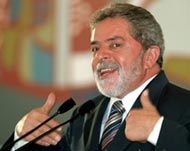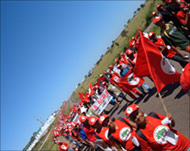Landless farmers march into history
Rising before dawn each day, 11,000 members of Brazil’s landless movement gather their mattresses, clothes and essentials and hit the highway for the next leg of their historic march for agrarian reform.

The Movimento dos Trabalhadores Rurais Sem Terra (Brazil’s Landless Workers Movement, MST), is five days into a 17-day march from the starting point of Goiania to the capital Brasilia.
Covering on average 15km a day in this 290km-journey, they create an extraordinary thin red line of three columns stretching four-and-a-half kilometres along the BR-060 motorway.
Onlookers on a bus in the city Anapolis gasp in astonishment at the size of the march, staring slack-jawed.
The MST, the largest social movement in Brazil, has never before attempted such a big undertaking in their 20-year history.
On this march, there are thousands of landless farmers from 23 states across the country – from Para in the Northeast to Santa Catarina in the South, a distance equivalent of travelling from Rome to Baghdad.
Thousands of Brazilians suffer grinding poverty as a result of disparities in land-ownership; less than 3% of the populatio owns two-thirds of the land. Many farmers are entirely without land.
Dirceu has come with 200 other landless from the poor northeastern state of Alagoas. It took three and a half days for them to arrive at the May Day starting point in the city of Goiania.
“We have been camped by the side of the road waiting for land for seven years and so far we have been given nothing,” he says.
“There are 100 families on the camp. Day-to-day life is very difficult. We don’t have jobs or work. We want land. We don’t have enough food to eat,” says Dirceu, a father of two children, seven and nine years old.
Below poverty levels
According to government statistics there are 52 million Brazilians living below the poverty line in this country of 186 million. Thirty million of them are malnourished while the majority live in the semi-arid northeast. Less than 1% of the people own as much as 45% of the land.
 |
|
President Lula was seen as being |
“We need agrarian reform. We hope the president will have compassion for us. Before we said he was 60% pro-landless and 40% pro-landowners. Now we think he is 90% pro-landowners and leaving us landless on the outside. He has to fulfil his promises,” Dirceu says.
From humble origins, President Ignacio Lula da Silva came to power in a first-time victory for the Workers’ Party and is a traditional ally of the MST. But the promises set out in the 2003 National Plan for Agrarian Reform to settle 430,000 families, are far from being realised. Less than 60,000 have been given land.
Charles Trocate, MST national coordinator, believes Lula is an ally of agrarian reform but there a lot of criticisms of how the government has handled the issue.
Conflicting interests?
He points to the fact there may be conflicting interests between the Ministry for Agrarian Development, which upholds the issue of reform, and the Ministry for Agriculture, which protects the interests of big landowners and agribusiness.
“Lula does ot have the strength to make the changes,” says Trocate, who is from the northeast state of Para where US nun and environmentalist Dorothy Stang was assassinated earlier this year.
 |
|
The marchers rise before dawn |
“The march is designed to help give more strength to our allies inside the government and put the issue back on the political agenda,” says Trocate.
“The death of Dorothy was nothing more than those with vested interests shutting the mouth of someone who defended the landless, agrarian reform and sustainable environmental development.
“The atmosphere of tension is still there. Anyone who stands in the way of large mining companies and other interests becomes a target and in many cases result in deaths.
“Reform is being blocked by agro-business which increases the concentration of land and increases the number of deaths, the number of conflicts, the amount of violence,” he told Aljazeera.net.
“It is also being blocked by continuing the same economic model. Lula must change this model. We maintain our autonomy from any political party and we haven’t yet discussed if we will support his bid for re-election in 2006,” he says.
Organising the march
The march is due to arrive in Brasilia on 16 May where the MST’s 14-point demands will be delivered to the government.
The coordination of the march is a huge feat. Thirty-one lorries, 15 water trucks and six ambulances accompany the marchers. A team of cooks prepare 22,000 meals a day using rice, beans, vegetables and some meat brought from already settled farmers from every state.
 |
|
Six ambulances and 14 water |
Each new day, an advance team sets off ahead of the march and occupies a farm, setting up circus tents and emergency infrastructure. The following morning everything is packed away and moved on to the next makeshift camp.
In the afternoons, each state camp divides into study groups, debating the reasons for the march, the MST movement and the finer details of agrarian reform. By early evening there is a festival spirit with sound systems and live music from each region. By 10pm almost the entire camp is asleep, exhausted.
More than 100 children are on the march. Those of school age receive daily lessons from 60 teachers while the youngest are looked after by their own brigades’, collective groups made up from each camp.
The oldest member marching, Luis Beltrame, is 97.
“The government is not helping us, the deputies, the senators – they don’t want to,” he says. “Lula hasn’t done anything and this is why we are marching. If he is our ally he needs to help us.”